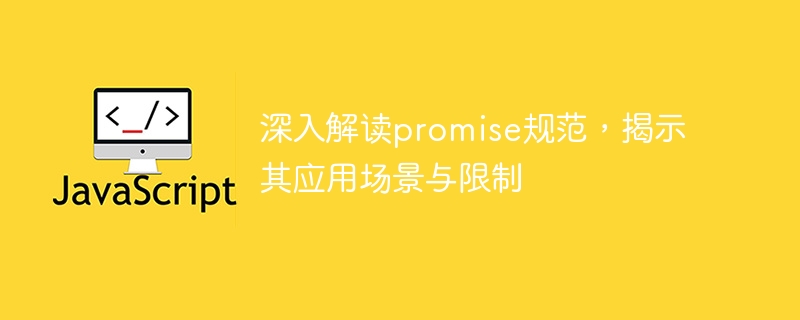Home >Web Front-end >JS Tutorial >A deep dive into promise specifications: application cases and limitations revealed
A deep dive into promise specifications: application cases and limitations revealed
- PHPzOriginal
- 2024-02-18 20:42:06850browse

In-depth interpretation of the Promise specification, revealing its application scenarios and limitations
Introduction:
In modern asynchronous programming, Promise is a very common programming pattern. It provides an elegant way to handle asynchronous operations. The Promise specification defines a unified set of API and behavior rules for us, allowing us to easily use, create and manage Promise objects. This article will deeply interpret the Promise specification, reveal its application scenarios and limitations, and hope to help readers better understand and apply Promise.
1. What is Promise?
Promise is an object used to handle asynchronous operations. It represents the final completion or failure of an asynchronous operation. Promise objects have three states: pending (waiting state), fulfilled (execution state) and rejected (rejection state). When the asynchronous operation is completed, the Promise's status will change from pending to fulfilled. If the asynchronous operation fails, the status will change to rejected. Promise can handle multiple asynchronous operations through chain calls, thus solving the problem of callback hell.
2. API in the Promise specification
In the Promise specification, the Promise object provides a set of standard APIs, including the following methods:
- then(onFulfilled, onRejected ): Used to register the callback function onFulfilled when the Promise object status changes to fulfilled, and the callback function onRejected when the Promise object status changes to rejected.
- catch(onRejected): Used to register the callback function when the Promise object state changes to rejected, equivalent to then(null, onRejected).
- finally(onFinally): Used to register a callback function that will be executed regardless of the state of the Promise object, whether fulfilled or rejected.
- Promise.resolve(value): Returns a Promise object that has been fulfilled, using the given value as the result.
- Promise.reject(reason): Returns a Promise object that has been rejected, using the given reason as the reason for rejection.
- Promise.all(promises): Returns a new Promise object. When all input Promise objects become fulfilled, the new Promise object will become fulfilled.
- Promise.race(promises): Returns a new Promise object. When any of the input Promise objects becomes fulfilled or rejected, the new Promise object will change to the same state.
3. Promise application scenarios
- Asynchronous operation processing: Promise can combine multiple asynchronous operations together and process them through chain calls. This avoids the problem of callback hell and makes the code clearer and readable.
- Concurrent requests: The Promise.all method can combine multiple concurrent requests together, and subsequent operations will only be performed when all requests return successfully.
- Error handling: The catch method can easily capture errors in the Promise chain and perform unified error handling.
- Cache management: Promise objects can be used to manage the reading and saving of the cache. When the cache expires, the cache can be updated through asynchronous operations.
4. Promise limitations and precautions
- Cannot be canceled: Once a Promise object is created, it cannot be canceled or aborted. When a Promise enters the fulfilled or rejected state, the state will never change.
- Unable to skip intermediate links: Once an error occurs in a certain link in the Promise chain, the error will be passed backwards until a catch or finally method is encountered. This means that if we want to skip some steps and continue to perform subsequent operations, we need to manually add a catch method to catch the error before the error occurs.
- Compatibility issues between different Promise implementations: Although the Promise specification defines unified behavior and API, different Promise implementations may have subtle differences, leading to compatibility issues when using each other. Therefore, when using Promise, we need to pay attention to choosing the appropriate Promise library.
Summary:
This article provides an in-depth interpretation of the Promise specification and reveals its application scenarios and limitations. As a programming model for handling asynchronous operations, Promise plays an important role in modern asynchronous programming. We should understand the basic concepts and common APIs of Promise, and use Promise appropriately to improve the readability and maintainability of the code. At the same time, we must also pay attention to the limitations and precautions of Promise to avoid unnecessary problems in actual use.
The above is the detailed content of A deep dive into promise specifications: application cases and limitations revealed. For more information, please follow other related articles on the PHP Chinese website!
Related articles
See more- Analysis of an example of limiting the size of multiple images uploaded by WeChat applet
- How to remove network speed limit on win7 computer
- What to do if the custom resolution exceeds the maximum bandwidth limit
- Artificial Intelligence: Introduction to application scenario knowledge of artificial neural networks
- PHP communication: How to handle large number of concurrent requests?

